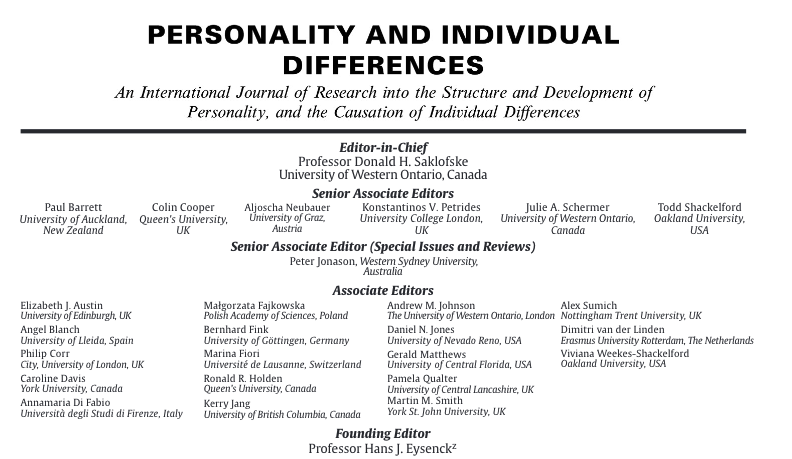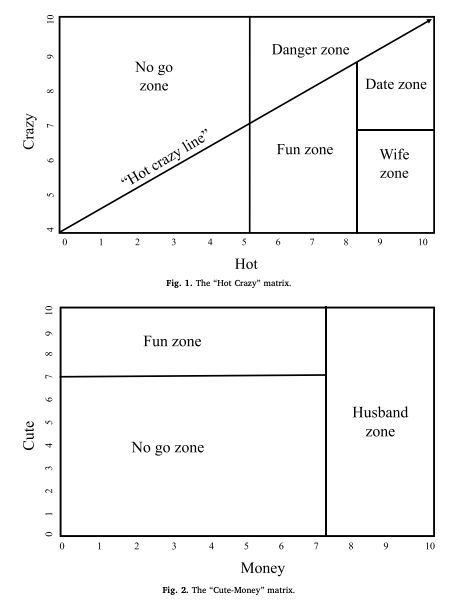Lots of buzz yesterday on Twitter about a paper already published online a year ago, but assigned to the February 2021 issue of Personality and Individual Differences, an Elsevier/Science Direct journal. The paper builds upon a popular — but not scientific — YouTube video in which men are advised to only date women who are “hot and not too crazy”, and women are believed to only want to marry rich guys.
Figures 1 and 2 of the paper — taken from this video but without giving credit — are presented in this paper as scientific data. Of course, I have concerns.
The paper was initially called Testing the hot-crazy matrix: Borderline personality traits in attractive women and wealthy low attractive men are relatively favoured by the opposite sex, but the first part of the title has now been removed. DOI: 10.1016/j.paid.2020.109964

The Hot-Crazy Matrix
The Hot-Crazy Matrix (HCM) comes from a popular YouTube video (close to 3 million views; not going to link to it but easy to find) in which a man draws a plot on a whiteboard that scores women according to two scales, “Hot” and “Crazy”. The Crazy scale starts at 4, the guy explains, “because of course there is no such thing as a woman who is not at least a 4 crazy“. The matrix is then divided into subsections of women that guys should avoid, called the No Go Zone (“we do not hang around and date and marry women who are not at least a 5 hot“), the Date Zone, and the Wife Zone (at least an 8 hot but not too crazy).
The video also features a Cute-Money Matrix (CMM) in which men are rated according to how cute they are and how much money they make. Women are advised to date only the rich guys.
I can see that this video is meant to be funny, and I am sure there is a place in the Interwebs for it, but in my personal view it’s far too simplistic and sexist to be featured in a scientific paper. And yet it was published in PAID.
The PAID journal – not without controversies
The Personality and Individual Differences journal in which the HCM paper was published focuses on “the Structure and Development of Personality, and the Causation of Individual Differences.”
The PAID journal was founded by Hans Eysenck, a German/British psychologist, who is one of the highest cited scientists in his field. His career has been very controversial, and since his death many of his papers have been investigated for data falsification and fabrication. His work is currently up to 15 retractions and 70+ expressions-of-concern (EoC), including several papers he published in his own PAID journal. PAID apparently did not want to retract these papers despite requests by academic institutions and only slapped EoCs on them. The journal has been accused of being too protective of its founder.
The HCM paper was published in Issue 169 of the PAID journal, which celebrates its 40th anniversary. It features several references to its founder, including a reprint of his original introductory editorial.

The paper: Hot or Not?
It is quite unexpected to see a journal specializing in the Causes Of Individual Differences publishing a paper driven by a sexist YouTube video that rates women for hotness and craziness, and judges men by their cuteness and the amount of money they make.
The Hot-Crazy Matrix and the Cute-Money Matrix are described in the introduction as “universal” and “popular”. The introduction of a scientific paper is usually the place where previous research is described and cited, so a naive reader might interpret the description of the HCM and CMM as genuine scientific knowledge.
Figures 1 and 2 in the paper feature both matrices without any clarification, as if they were real scientific data, with actual measurements and actual scales. There is no citation to the YouTube video or other sources, no disclaimer that this is not actual data, and not even an explanation of the meaning and differences between the two graphs.

The paper raises all kinds of issues, including categorizing all men as only wanting to date women and vice versa; categorizing women only on hotness and craziness and men only for their money; assuming all women are somewhat crazy, etc. On top of this it labels a person with a mental illness — borderline personality disorder — “crazy”, which is both demeaning and unscientific.
My PubPeer comments
Of course, I had some thoughts about the paper, and I voiced my comments on PubPeer. Here is a copy of my post.
In this paper, two groups of male and female participants were recruited through online crowd-sourcing platforms. They were then presented with a combination of a photo of a face and a personality profile.
- The photo was either a high- or a low-attractive Caucasian face taken from an online library.
- The personality profile was presented in the form of a short scenario about how the participant met the person in the photo, and the events that followed. In study A, the scenario included data on the “psychopathy” traits of the person in the photo, while in study B the scenario described whether the person was rich or poor. These scenarios were written in neutral (not gendered) language.
Study participants were then asked about the “extent you would want to be romantically involved with this person” on a short-term and long-term dating basis.
I have several questions and concerns.
Let’s start with some important details that appear to be missing from the Methods section.
- Did the authors obtain IRB approval for this research? Were the participants asked for consent for this study? I cannot seem to find any statement on this.
- Did the authors know the sexual orientation of the participants? Did the male subjects only see images of females, and vice versa? Or did the participants get to see a random photo? This seems relevant to the question asked of participants about whether they would want to be romantically involved. However I cannot seem to find these important details.
- Which faces from the “Beautycheck” library were used for this research?
Now let’s move on to another big concern I have with this paper, Figures 1 and 2.
- Figure 1 represents “men’s dating options based on rating women on two dimensions: “hot” (attractiveness) and “crazy” (emotionality), in reference to a third criteria; the “hot-crazy line”.
- Figure 2 shows “the cute money matrix (CMM) (Fig. 2) in which a man’s desirability depends on how attractive and wealthy they are.”
At first I thought these figures represented the data as measured in this paper, since they are, well, presented as data. However, they appear to be based on what the authors describe thus: “The universal hot crazy matrix (HCM) (otherwise known as the “single guy’s guide to dating women”) is a popular cultural phenomenon, and has featured in American sitcoms and viral YouTube videos”.
Well, I can think of a lot of popular memes that lack scientific truth, but I would not expect them to be presented as the truth in a scientific paper.
Why is a sexist image like this presented as scientific data/truth? Why do the authors use fallacies such as “universal” and “popular”, and not present this as a hypothesis using unbiased language? Why can women only be “Hot” and “Crazy”, and why can men only be “Cute” and “Rich”? It seems completely unnecessary to include sexist language like this in a scientific paper, especially if it is presented as data.
Also, calling people with personality disorders “crazy” is without question entirely unscientific and unacceptable.
And finally, why was the sexist “Testing the hot-crazy matrix” part removed from the title? I would of course never use Sci-hub since it is not legal, but the copy deposited there shows that some version of this paper had a different title than it now has. Archived here: https://web.archive.org/web/20210212220559/https://sci-hub.st/10.1016/j.paid.2020.109964

Sure this paper isn’t playing us as a spoof or a Sokal style sting? Seems like the level of rigor is more like The Onion than an academic paper, such as ….
https://www.theonion.com/new-england-journal-of-teen-medicine-retracts-flawed-1846201374
LikeLiked by 1 person
entirely agree with you – this utter nonsense should never have seen the light of day, never mind been published in a so-called “scientific” journal.
But PAID has fatally refused to un-hitch their wagon from the flawed and fraudulent Eysenck, whose narcissism and dogmatic views ultimately led him to believe he was entitled to manipulate data to prove his point.
His ridiculous and specious arguments for the tobacco industry (he argued that the personality traits that lead to smoking also made one prone to cancer!) were rendered blatantly in return for filthy lucre.
Now this journal it seems is willing to publish something that more properly belongs on Reddit or the Onion. Certainly the authors’ claims to pretend that this demonstrates anything about evolutionary theory would seem seriously undermined by the absence of any actual – er – scientific data from their paper.
Did this thing actually undergo peer review? Did no-one, even the editors not notice the sexist and offensive language regarding psychiatric terms? Borderline Personality Disorder is a most distressing condition both for the sufferer and for those who interact with them – it is not something to poke fun at. Rather it deserves empathy and understanding.
This kind of junk science is not only insulting to women and those with BPD – it is an insult to all real scientists and does real harm to the reputation of science in the eyes of the public and the media.
PAID should be censured for ever having published it.
LikeLike
I disagree with some of the contentions by the blogger. The authors never say that the HCM represents scientific data; all they say is that it’s a cultural phenomenon. Then they go on to say that it dovetails well with some scientific data, and they cite the source of these data.
LikeLiked by 1 person
I had the same concerns when I read this paper. I am glad someone is writing about this.
LikeLike
Well, testing popular conception to prove they are either truth in hindsight or misconceptions is common in social science, but indeed this could have been made more rigorously, here it feels like a joke, even though the basics of the article methodology are not so bad (more like lacking precision than adopting a processus that is completely foolish regarding the question asked).
Still I appreciate this blog and its unrelenting research of truth, even in the smallest details.
LikeLike
Everything looks fun and stupid. This article is certainly a prank. the intersting part is : was the editor pranked or knows it’s a joke. If so, why he doesn’t present the paper as a joke.
LikeLike
It’s worth noting that the first author (Blanchard) is on the Editorial Board of PAID and, from a scan of her Google Scholar page, it appears that 8 of her 12 peer-reviewed articles, including this one, are published in PAID. Make of this what you will?
LikeLike